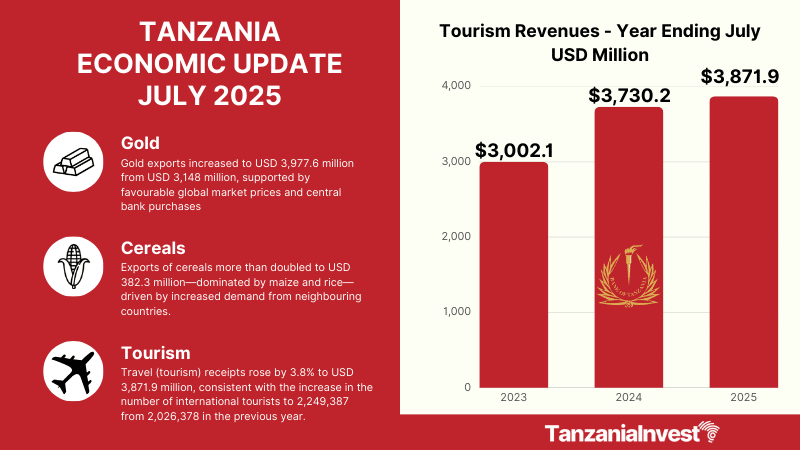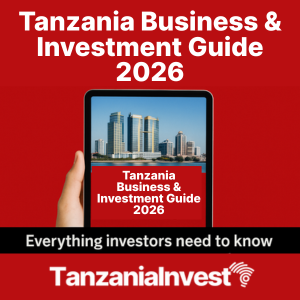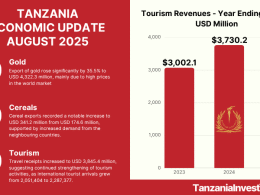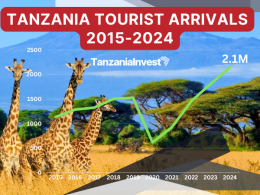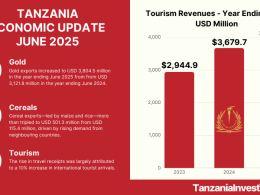The Bank of Tanzania (BoT) has released its Monthly Economic Review–August 2025, outlining Tanzania’s economic performance for the year ending July.
Table of Contents
Inflation
Inflation remained stable during the review period, consistent with both country’s target range of 3-5% and regional convergence benchmarks.
In July 2025, inflation stood at 3.3%, unchanged from the preceding month.
This stability reflected offsetting dynamics within the inflation basket—an uptick in food inflation was counterbalanced by a deceleration in non-food components, notably in energy, fuel, and utility.
Food inflation was 7.6% in July 2025, rising from 7.3% in June 2025 and 1.0% in July 2024. The increase was primarily driven by rising prices of key staple and alternative food items, particularly rice and finger millet.
In July 2025, the National Food Reserve Agency released a net total of 1,855.3 tonnes of maize.
Despite this drawdown, the Agency maintained a robust stock level of 485,930.4 tonnes, which was significantly higher than the 368,855 tonnes recorded during the same period in 2024.
This increase was primarily attributed to good harvests in the preceding crop season and adequate budgetary allocations for strategic grain procurement.
Core inflation remained unchanged at 1.9% in July 2025, the same as in June 2025 and down from 3.6% in July 2024, reflecting limited price pressures across non-volatile categories such as housing and services.
This outcome was further reinforced by the continued easing of global commodity prices.
In terms of contributions, unprocessed food inflation remained dominant for the second consecutive month, followed by core and energy subgroups.
Inflation for energy, fuel, and utilities decreased to 1.0% in July 2025, from 2.1% in the previous month.
The deceleration was primarily attributed to the sustained decline in wood charcoal prices.
In addition, petroleum product prices—including petrol, diesel, and kerosene—continued to trend downward throughout the month, in line with movements in the global oil market.
This price moderation played a key role in supporting the overall stabilization of headline inflation.
Monetary Policy
In July 2025, at its 237th meeting, the Monetary Policy Committee resolved to lower the Central Bank Rate (CBR) to 5.75% from 6.00% for the quarter ending September 2025.
In light of a subdued inflation outlook, diminishing risks from global uncertainties, and strengthening domestic economic conditions, a decision was made to stimulate credit growth and boost economic activity.
To this end, the Bank is implementing monetary policy measures to maintain the 7-day interbank cash market (IBCM) rate within a corridor of 3.75% to 7.75%.
The monetary policy operations in July 2025 were satisfactory, ensuring the level of liquidity in the economy remained adequate.
Accordingly, the Bank conducted reverse repo operations amounting to TZS 758.8 billion, aiming to steer the 7-day IBCM rate within the CBR corridor.
Extended broad money supply (M3) grew at an annual rate of 19.9% in July 2025, compared with 18.7% registered in the preceding month and in line with the current monetary policy stance.
This growth was mainly driven by the sustained expansion of credit to the private sector.
Banks’ Credit to the Private Sector
Private sector credit growth continued to be strong, at 15.9%, consistent with the levels registered in the preceding month.
Agricultural activities continued to record the highest growth of credit at 31.8%, followed by mining and quarrying, and transport and communication that grew by 26.2% and 21.6%, respectively.
Meanwhile, personal loans, which are mainly used to finance micro, small, and medium-sized enterprises, accounted for the lion’s share of private sector credit at 35.5%, followed by trade and agriculture at 14% and 13.3%, respectively.
Interest Rates
Lending and deposit interest rates remained broadly unchanged in July 2025.
The overall lending rate decreased marginally to 15.16% from 15.23% in the preceding month.
Similarly, lending rates to prime customers (negotiated rates) eased to 12.56% from 12.68%.
Overall deposit rate edged up to an average of 8.83% from 8.74%.
On the other hand, the negotiated deposit rate registered a slight decrease to 10.72% from 11.21% in the previous month.
The short-term interest rate spread between one-year lending and deposit rates narrowed to 5.63 percentage points from 6.66 percentage points recorded in the corresponding month in 2024.
Financial Markets
Government Securities Market
During the month under review, the Bank conducted two Treasury bill auctions with a total tender size of TZS 162.0 billion, primarily to finance government budgetary operations, with a small portion aimed at facilitating price discovery for short-term financial instruments.
Reflecting adequate liquidity conditions, the auctions attracted bids amounting to TZS 452.1 billion, with TZS 158.9 billion successful.
Consistently, the overall weighted average yield decreased slightly to 8.13% from 8.89% recorded in the preceding month.
The Bank also conducted 2-, 5-, and 10-year Treasury bonds auctions, with a tender size of TZS 117.05 billion, TZS 136.2 billion, and TZS 162.8 billion, respectively.
The 2- and 5-year Treasury bond auctions were undersubscribed, while the 10-year was oversubscribed, reflecting investors’ continued preference for instruments with longer maturities.
Collectively, bids received amounted to TZS 396.4 billion, of which TZS 351.9 billion were accepted.
Weighted average yields increased slightly to 12.17% and 13.18% for the 2- and 5-year bonds, respectively, while that of the 10-year bond eased marginally to 13.74%.
Interbank Cash Market
The interbank cash market (IBCM) continued to facilitate the transmission of monetary policy by enabling the trading of shilling liquidity among banks.
The market registered a turnover of TZS 3,746 billion in July 2025, up from TZS 2,873.9 billion traded in the previous month.
The 7-day transactions dominated the market, accounting for 65.9% of total market turnover.
The overall IBCM interest rate eased to 6.62% compared to 7.93% in June 2025.
Interbank Foreign Exchange Market
Liquidity conditions in the Interbank Foreign Exchange Market (IFEM) improved further in July 2025, supported by seasonal inflows from cash crops and gold exports.
Accordingly, the IFEM turnover increased to USD 162.5 million from USD 121.5 million in June 2025.
The Bank intervened in the market, in line with the Foreign Exchange Intervention Policy, auctioning USD 17.5 million compared with USD 6.3 million in the previous month.
The shilling remained stable against major currencies, trading at an average of TZS 2,666.79 per USD in July 2025, compared to TZS 2,631.56 per USD in the previous month.
Accordingly, the shilling depreciated steadily at an annual rate of 0.11% compared with 0.21% in the preceding month.
Government Budgetary Operations
In June 2025, government revenue collections exceeded the monthly target by 5.1%, reaching a total of TZS 3,753.4 billion.
The Central Government contributed TZS 3,579.2 billion, accounting for 95.4% of total domestic revenue, above the monthly target by 3.9%.
Tax revenue continued to show strong performance, amounting to TZS 3,108.7 billion, which was 7.8% above the monthly target.
This reflects the positive impact of ongoing enhancements in tax administration.
In contrast, non-tax revenue totalled TZS 470.5 billion, falling short of the target of TZS 561.5 billion.
In June 2025, the Government successfully aligned its expenditures with available resources, with total spending reaching TZS 3,350.0 billion.
This expenditure was composed of TZS 2,440.6 billion in recurrent spending and TZS 909.4 billion for development projects.
Debt Developments
The national debt stock at the end of June 2025 was USD 46,586.6 million, 1% higher than the stock at the end of the preceding month. Of the debt stock, 70.7% was external debt.
External Debt
The external debt stock (public and private) recorded a monthly increase of 0.1% to USD 32,955.5 million at the end of June 2025.
Of this amount, 85.4% was public debt, while the remainder was private sector debt.
External loan disbursed during the month amounted to USD 868.4 million, while external debt service payments totalled USD 234.4 million, of which USD 173.6 million was for principal repayments.
The composition of external debt by creditor remained broadly unchanged from the preceding month and the corresponding month in 2024, with multilateral institutions continuing to account for the largest share of the stock, followed by commercial lenders.
Transportation and telecommunications activities remained the largest holders of the disbursed outstanding debt, while the US dollar continued to dominate the currency composition of external debt, followed by the Euro.
Domestic Debt
Domestic debt reached TZS 35,351.4 billion at the end of July 2025, reflecting a 0.4% decline from the previous month, mainly due to decreased use of the overdraft facility.
Long-term instruments—Treasury bonds—continued to dominate the domestic debt portfolio, with commercial banks and pension funds remaining the main domestic creditors of the Government.
In July 2025, the Government borrowed a total of TZS 514.4 billion from the domestic market to finance its budget.
Of the amount, TZS 356.8 billion was raised through Treasury bonds and TZS 157.6 billion through Treasury bills.
Furthermore, the Government disbursed a total of TZS 670.8 billion for domestic debt servicing, comprising TZS 342.3 billion in principal repayments and TZS 328.5 billion in interest payments.
The position of outstanding domestic debt of select State-Owned Enterprises (SOEs) at the end of July 2025 remained unchanged from that recorded at the end of the preceding month.
External Sector Performance
The external sector continued to improve during the year ending July 2025, manifested by a narrowing current account deficit to USD 2,079.2 million from USD 2,713.5 million during the same period in 2024.
This development was primarily driven by the uptick in exports of goods and services relative to imports.
The stock of foreign exchange reserves amounted to USD 6,194.4 million at the end of July 2025, up from USD 5,292.2 million recorded in the same period of 2024.
This level of reserves is adequate to cover 5 months of projected imports of goods and services, surpassing both national and EAC adequacy benchmarks.
Exports
During the year ending July 2025, exports of goods and services rose by 14% to USD 16,655 million.
The rise in exports was driven by travel receipts and non-traditional exports, mainly gold, alongside traditional exports.
Exports of goods rose by 19.7% to USD 9,479.4 million in the year to July 2025.
The main contributors were gold, cashew nuts, horticultural products, coffee, and cereals, particularly maize and rice.
In terms of value, gold exports increased to USD 3,977.6 million from USD 3,148 million, supported by favourable global market prices and central bank purchases.
Traditional exports reached USD 1,388 million compared with USD 1,074.4 million, driven mainly by cashew nuts and coffee, due to both price and volume effects.
Exports of cereals more than doubled to USD 382.3 million—dominated by maize and rice—driven by increased demand from neighbouring countries.
On a monthly basis, goods exports stood at USD 551.3 million in July 2025, compared with USD 847.1 million in July 2024.
Service receipts grew to USD 7,175.6 million, up from USD 6,643.8 million in the year ending July 2024. The growth was largely driven by travel and transportation receipts.
Travel (tourism) receipts rose by 3.8% to USD 3,871.9 million, consistent with the increase in the number of international tourists to 2,249,387 from 2,026,378 in the previous year.
Imports
Imports of goods and services in Tanzania reached USD 17,645.4 million in the year ending July 2025, up from USD 16,260 million in the corresponding period of 2024.
The increase was largely driven by higher imports of industrial transport equipment, industrial supplies, iron and steel, and parts and accessories.
Imports of petroleum products, however, declined to USD 2,689.1 million from USD 2,846.1 million, reflecting a 14.2% drop in global oil prices to USD 71.6 per barrel.
On a monthly basis, imports of goods were broadly stable, totaling USD 1,099.6 million in July 2025 compared with USD 1,085.6 million in July 2024.
Service payments grew to USD 2,925.1 million in the year ending July 2025, up from USD 2,414.5 million in 2024, driven by higher freight costs in line with the growth in goods imports.
On a monthly basis, service payments stood at USD 241.2 million in July 2025 compared with USD 230.6 million in July 2024.
The primary income account recorded a deficit of USD 1,818.8 million in the year to July 2025, up from USD 1,638.7 million a year earlier, following increased payments on equity and interest.
On a monthly basis, the deficit widened to USD 197.8 million in July 2025 from USD 116.1 million in July 2024.
The secondary income account registered a surplus of USD 730 million in the year ending July 2025, compared with USD 623.2 million in the previous year, supported by a rise in personal transfers.
On a monthly basis, the surplus amounted to USD 110.6 million in July 2025 compared with USD 50 million in July 2024.





